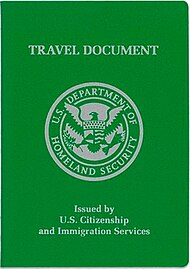U.S. re-entry permit
| Re-entry Permit | |
|---|---|
 | |
| Type | Travel document |
| Issued by | |
| Purpose | Identification |
| Eligibility | Permanent residence |
| Expiration | At most two years |
The Re-entry Permit (Form I-327) is a travel document similar to a certificate of identity, issued by the United States Citizenship and Immigration Services to U.S. lawful permanent residents to allow them to travel abroad and return to the United States.[1] It is a green passport-like booklet with the words Travel Document, a symbol, and other official wording in blue-gray. Individuals whose application for permanent residency has not yet been approved can apply instead for advance parole (Form I-512).
Purpose
The re-entry permit enables a lawful permanent resident (LPR) of the U.S. to travel outside the United States for time periods longer than one year and establishes that the LPR does not intend to abandon residence in the U.S. A re-entry permit prevents two problems:
- An LPRs absence from the U.S. for over one year voids their Permanent Resident Card, in turn rendering the LPR as invalid for re-entry to the U.S.
- An LPR taking up residence in an alternative country to the U.S (prior to the one year point) voids their Permanent Resident Card as the U.S. Citizen and Immigration Services considers the action as an abandonment of U.S. permanent residency
If a U.S. permanent resident intends to take a trip abroad for over one year, they may apply for a re-entry permit. The resident is granted to travel for up to two years abroad without having to obtain a returning resident visa. It establishes that the permanent resident did not intend to abandon permanent resident status.[2]
Another purpose for the re-entry permit is to serve as an international travel document instead of a passport for U.S. permanent residents who are stateless, who cannot get a passport from their country, or who wish to travel to a place where they cannot use their passport.[3] A permanent resident who obtained permanent residence as a refugee may either apply for a refugee travel document or a re-entry permit, but not both.

USCIS Form I-131 (Application for a Travel Document) is used to apply for the re-entry permit and other travel documents. This form can only be filed while the applicant is still in the United States.[4]
Acceptance in EU
As of 2013, most Schengen Area countries accept the U.S. Re-entry Permit for visa issuance purposes. The Re-entry Permit is considered as an Alien's Travel Document.[5]
Only Slovakia has explicitly indicated they will accept it, while other countries did not provide any information on their acceptance of it.
Accepting Countries
 Austria
Austria Belgium
Belgium Czech Republic
Czech Republic Denmark
Denmark Finland
Finland France
France Germany
Germany Greece
Greece Hungary
Hungary Iceland
Iceland Italy
Italy Latvia
Latvia Liechtenstein
Liechtenstein Lithuania
Lithuania Luxembourg
Luxembourg Netherlands
Netherlands Norway
Norway Portugal
Portugal Slovakia
Slovakia Slovenia
Slovenia Spain
Spain Sweden
Sweden Switzerland
Switzerland
See also
- 1954 Convention Travel Document
- 1954 Convention Relating to the Status of Stateless Persons
- 1961 Convention on the Reduction of Statelessness
- Nansen passport
References
- ^ "I-131, Application for Travel Document". USCIS. Retrieved 2019-10-09.
- ^ How Do I... Get a Reentry Permit (PDF), U.S. Citizenship and Immigration Services, August 2008
- ^ "Advance Parole, Reentry Permit, and Refugee Travel Documentation for Returning Aliens Residing in the U.S | U.S. Customs and Border Protection". www.cbp.gov. Retrieved 2019-10-09.
- ^ I-131
- ^ Table of travel documents entitling the holder to cross the external borders and which may be endorsed with a visa, Council of the European Union, February 2013, p. 136, archived from the original on 2013-08-30, retrieved 2013-09-28
